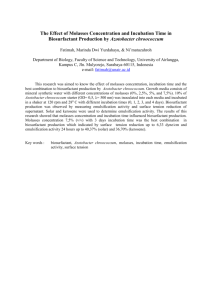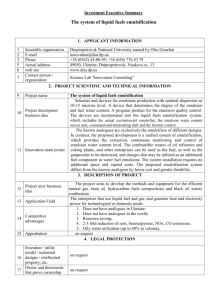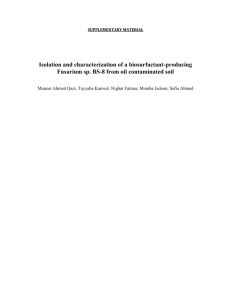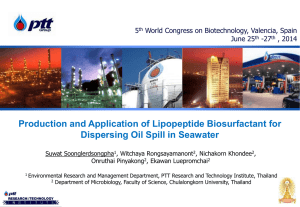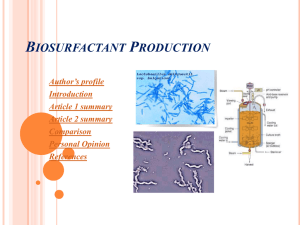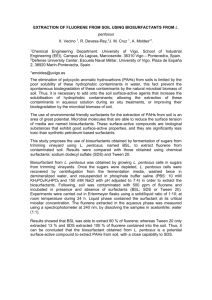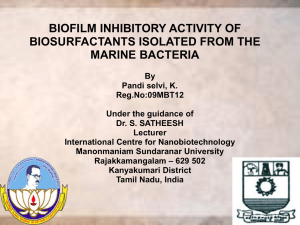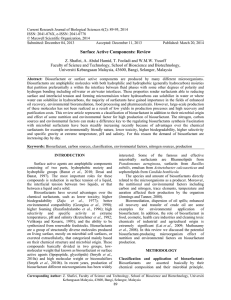International Journal Of Engineering And Computer Science ISSN:2319-7242
advertisement
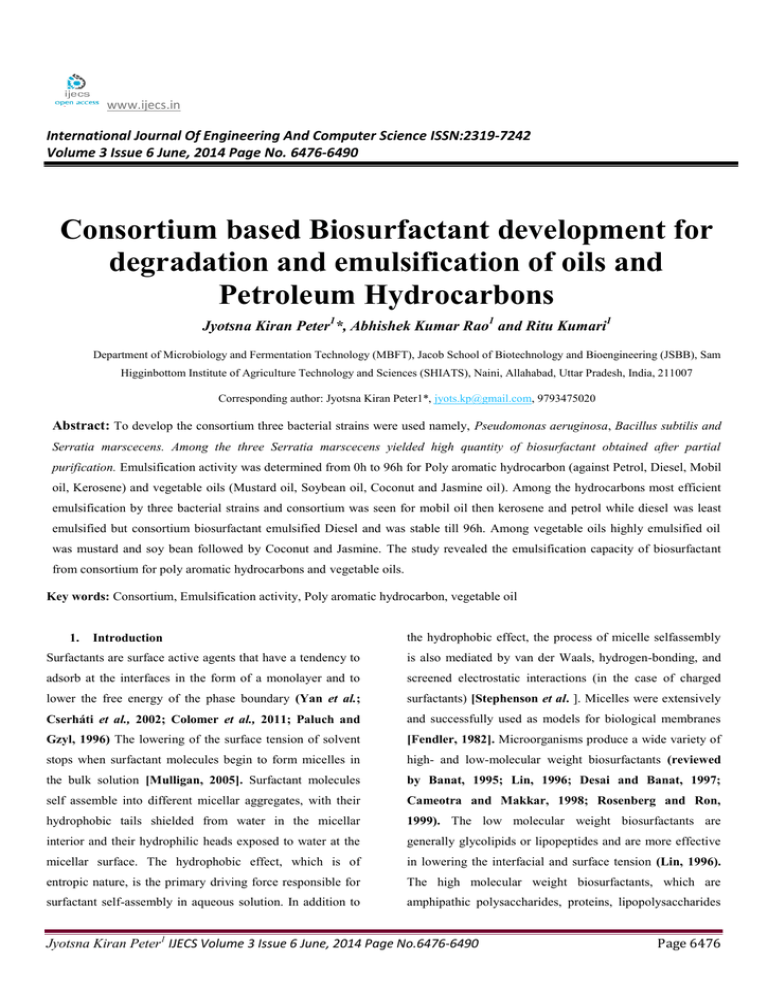
www.ijecs.in International Journal Of Engineering And Computer Science ISSN:2319-7242 Volume 3 Issue 6 June, 2014 Page No. 6476-6490 Consortium based Biosurfactant development for degradation and emulsification of oils and Petroleum Hydrocarbons Jyotsna Kiran Peter1*, Abhishek Kumar Rao1 and Ritu Kumari1 Department of Microbiology and Fermentation Technology (MBFT), Jacob School of Biotechnology and Bioengineering (JSBB), Sam Higginbottom Institute of Agriculture Technology and Sciences (SHIATS), Naini, Allahabad, Uttar Pradesh, India, 211007 Corresponding author: Jyotsna Kiran Peter1*, jyots.kp@gmail.com, 9793475020 Abstract: To develop the consortium three bacterial strains were used namely, Pseudomonas aeruginosa, Bacillus subtilis and Serratia marscecens. Among the three Serratia marscecens yielded high quantity of biosurfactant obtained after partial purification. Emulsification activity was determined from 0h to 96h for Poly aromatic hydrocarbon (against Petrol, Diesel, Mobil oil, Kerosene) and vegetable oils (Mustard oil, Soybean oil, Coconut and Jasmine oil). Among the hydrocarbons most efficient emulsification by three bacterial strains and consortium was seen for mobil oil then kerosene and petrol while diesel was least emulsified but consortium biosurfactant emulsified Diesel and was stable till 96h. Among vegetable oils highly emulsified oil was mustard and soy bean followed by Coconut and Jasmine. The study revealed the emulsification capacity of biosurfactant from consortium for poly aromatic hydrocarbons and vegetable oils. Key words: Consortium, Emulsification activity, Poly aromatic hydrocarbon, vegetable oil 1. Introduction the hydrophobic effect, the process of micelle selfassembly Surfactants are surface active agents that have a tendency to is also mediated by van der Waals, hydrogen-bonding, and adsorb at the interfaces in the form of a monolayer and to screened electrostatic interactions (in the case of charged lower the free energy of the phase boundary (Yan et al.; surfactants) [Stephenson et al. ]. Micelles were extensively Cserháti et al., 2002; Colomer et al., 2011; Paluch and and successfully used as models for biological membranes Gzyl, 1996) The lowering of the surface tension of solvent [Fendler, 1982]. Microorganisms produce a wide variety of stops when surfactant molecules begin to form micelles in high- and low-molecular weight biosurfactants (reviewed the bulk solution [Mulligan, 2005]. Surfactant molecules by Banat, 1995; Lin, 1996; Desai and Banat, 1997; self assemble into different micellar aggregates, with their Cameotra and Makkar, 1998; Rosenberg and Ron, hydrophobic tails shielded from water in the micellar 1999). The low molecular weight biosurfactants are interior and their hydrophilic heads exposed to water at the generally glycolipids or lipopeptides and are more effective micellar surface. The hydrophobic effect, which is of in lowering the interfacial and surface tension (Lin, 1996). entropic nature, is the primary driving force responsible for The high molecular weight biosurfactants, which are surfactant self-assembly in aqueous solution. In addition to amphipathic polysaccharides, proteins, lipopolysaccharides Jyotsna Kiran Peter1 IJECS Volume 3 Issue 6 June, 2014 Page No.6476-6490 Page 6476 and lipoproteins, are effective stabilizers of oil-in-water plants (Compant et al., 2005; Haas and Défago 2005; emulsions (Gutnik and Shabtai, 1987; Ward et al., 2006). Pieterse et al., 2002; Ryu et al., 2003). The diverse life Soybean oil is a mixture of triglycerides consisting of styles of Pseudomonas spp. and the complexity of their saturated and unsaturated fatty acids. The presence of interactions with multiple hosts have been the subject of double bonds allows for the modification of the structure of numerous molecular, biochemical, and ecological studies soybean oil. Epoxidation is a method commonly used to (Ramos, 2004). Rhamnolipids produced by P. aeruginosa modify soybean oil. The double bonds are converted into strains have four main structural types: monorhamnolipid more reactive epoxide or oxirane ring groups by reacting acid, monorhamnolipid methyl ester, dirhamnolipid acid with peracids or peroxides. The benefits of epoxidized (dR-A), and dirhamnolipid methyl ester (dR-Me). These soybean oil (ESO) include its low toxicity, low irritancy, rhamnolipids can be produced in mixtures that vary in and lack of carcinogenic or non-genotoxic effects (BIBRA, composition (Zhang and Miller, 1995). Serrawettin W1 1988; EFSA, 2004). produced by Serratia marcescens is a surface-active The spore-forming bacterium, Bacillus subtilis, is an exolipid resulting in a lot foam formation during the 2, 3- important organism for the molecular genetic study of butanediol (2, 3-BD) fermentation Process (Zhang et al., peptide synthesis. Lipopeptides represent a unique class of 2010). bioactive microbial secondary metabolites, and many of them show attractive therapeutic and biotechnological properties [Maget Danna and Peypox, 1994; Katz and 2. Materials and Methods 2.1 Place of work done Demain, 1977]. The surfactin family encompasses structural variants but all members are heptapeptides interlinked with a bhydroxy fatty acid to form a cyclic lactone ring structure [Peepox et al., 1999]. They are powerful biosurfactants with exceptional emulsifying and foaming properties. Because of their amphiphilic nature, surfactins can also readily associate and tightly anchor into lipid layers and can thus interfere with biological membrane integrity in a dosedependent manner. Studies on lipid vesicles suggest that at low concentration [surfactin-to-lipid mole ratio (Rb) <0.04 in the membrane] surfactins insert exclusively in the outer leaflet of the membrane inducing only limited perturbation. At intermediate concentration (Rb 0.05–0.1) they provoke a transient permeabilization, but membranes The study was conducted at laboratory of Department of Microbiology and Fermentation Technology (MBFT), Jacob School of Biotechnology and Bioengineering (JSBB), Sam Higginbottom Institute of Agriculture Technology and Sciences (SHIATS), Naini, Allahabd, India. 2.2 Study materials Bacterial strains were procured from Microbial Culture Collection Bank (MCCB), Department of Microbiology and Fermentation Technology (MBFT), Jacob School of Biotechnology and Bioengineering (JSBB), Sam Higginbottom Institute of Agriculture Technology and Sciences (SHIATS), Naini, India in Nutrient agar slants. reanneal. Irreversible pore formation then occurs at higher ratios (Rb Name of bacteria 0.1–0.2) because of the insertion of surfactin-rich clusters in Pseudomonas aeruginosa the membrane. Further addition of surfactins to reach the Bacillus subtilis critical micellar concentration (CMC) leads to complete disruption and solubilization of the lipid bilayer with Serratia marscecens formation of mixed micelles (at Rb 0.22) [Heerklotz and 2.3 Maintenance of bacterial culture Seeling, 2007; Carrillo, 2003]. The genus Pseudomonas not only harbors plant- and humanpathogenic species, but also accommodates species The bacterial cultures were sub cultured routinely at 15 days interval on Nutrient agar slants (COMPOSITION :) incubated at 35˚C for 24 hours. that promote plant growth, degrade xenobiotic compounds, antagonize plant pathogenic fungi, or induce resistance in 2.4 Study Design Jyotsna Kiran Peter1 IJECS Volume 3 Issue 6 June, 2014 Page No.6476-6490 Page 6477 The study was conducted with following objectives I. To Produce and partially purify biosurfactant from bacterial consortium and individual bacteria in To characterize the biochemical nature of biosurfactants produced III. Then the contents were centrifuged at 8000 rpm for 30 minutes. The pellet was obtained at the bottom of centrifuge tube. The pellet was collected as a partially purified submerged batch mode operation II. allowed to stand for 10 hours at 4°C (Ilori et al., 2005). biosurfactant and stored in a screw capped bottle at refrigerating condition for further use. To analyze emulsification activity of individual biosurfactant of Bacillus subtilis and Serratia marscecens and consortium bio surfactants was partially purified using –methanol Chloroform extraction system in ratio of 2:3 added to the supernatant. 2.5 Drop Collapse assay Then the pH of the contents was dropped to 2 using conc. Petrol/Diesel oil (2µl) was added to Petriplate lid. The lid HCl. The flask was kept in refrigerator at 4˚C overnight. was pre-equilibrated for 1 hour at room temperature, and Then the contents were centrifuged at 8000rpm for 30 then 5µl of the culture supernatant was added to the surface minutes. The pellet was obtained at the junction of organic of oil. The shape of the drop on the oil surface was inspected and aqueous phase. The pellet was collected as a partially after 1 minute. Biosurfactant containing cultures will give purified biosurfactant and stored in a screw capped bottle at flat drops, thus indicating a positive result. refrigerating condition for further use. 2.6 Production, extraction and Partial purification of For extraction of biosurfactant from consortium a solvent biosurfactants extraction method was used. Solvent were selected on the Biosurfactant production was conducted in submerged batch basis of the prior extraction methods. A solvent system was culture operation using starter culture of 10% of the bacteria developed as 3parts acetone, two parts chloroform and one in grown in Nutrient broth medium. The seed culture was part of methanol to extract the biosurfactants from grown till stationary phase and inoculated to 100 ml of consortium. The pellets were obtained at bottom of Bushnell Haas broth supplemented with 2% Mustard oil as centrifuge tube as well as at junction of the aqueous and Soul Carbon Source in 250 ml capacity Erlenmeyer flasks organic phase. The pellets were collected in a screw capped duly cotton plugged. The flasks were kept in shaker bottle to be used further. incubator at 35˚C and 160 rpm for 10 days. An uninoculated 2.7 Characterization based on biochemical composition flask was used to check any contamination. of 2.6.1 Crude extraction of biosurfactants biosurfactant After 10 days of incubation the contents of the flask were The supernatant was analyzed for protein and carbohydrate centrifuged at 8,000 rpm for 30 mins. The cell pellet was content. discarded that contained the bacterial or consortium cell 2.7.1 Determination of dry weight of surfactant biosurfactant Biochemical composition of debris. The supernatant was filtered using Whatmann no 1 filter paper that contained the biosurfactant which was used as crude biosurfactant and was further purified using solvent extraction method. Sterilized petriplate was taken and the weight of the plate was measured in grams. Now the sediment was poured on the plate and placed in the hot air oven for drying at 100 °C for 30 minutes. After drying the plates were weighed 2.6.2 Solvent extraction and precipitation: Biosurfactant purification from Pseudomonas aeruginosa (Anandraj and Thivakaran, 2010). The dry weight of the biosurfactants was calculated using the following formula: was done through chilled acetone precipitation method for which the clear sterilized supernatant of the crude Dry weight of biosurfactants = Weight of the plate after drying - weight of the empty plate biosurfactant was precipitated using three 2ml of chilled Acetone added to one part of supernatant i.e. 1:3 ratio and Jyotsna Kiran Peter1 IJECS Volume 3 Issue 6 June, 2014 Page No.6476-6490 Page 6478 2.7.2 Estimation of total protein content of the Concentration biosurfactant of BSA (mg/ml) Protein content in the sample was estimated by the Lowry‟s Sample size: 5 method (Lowry, 1951). The total protein concentration is exhibited by a colour change of the sample solution in proportion to protein concentration, which can then be measured using colorimetric techniques. Standard stock solution (1mg/ml) of Bovine Serum Albumin (BSA) was prepared and transferred to different test tubes in different Intercept (a): -0.038999999999999 Slope (b): 1.175 Regression line equation: y=1.175x0.038999999999999 aliquots of 0, 0.2, 0.4, 0.6. 0.8 and 1ml and final volume in 2.7.3 Determination of carbohydrate content of the each test tube was made up with distilled water to 1ml to biosurfactant produce concentration range of 0, 0.2mg/ml, 0.4mg/ml, 0.6mg/ml, 0.8mg/ml, 1mg/ml. In another test tube 0.5ml of Determination of WSC using phenol-sulphuric acid (Dubois sample was taken and again its volume was made up to 1ml et. al., 1956) is based on the absorbance at 490 nm of a by distilled water. After this, fresh reagents were prepared coloured aromatic complex formed between phenol and the i.e. Reagent A, Reagent B, Reagent C and Reagent D, then carbohydrate. The amount of WSC present was determined 5ml of Reagent C was added in each test tube and all test by comparison with a calibration curve using a calorimeter. tubes was kept at room temperature for 10min under dark. 1 mg/ml of standard stock solution of glucose was prepared Then 0.5ml of Reagent D (F-C Reagent) was added in each in distilled water. The aliquots was transferred to 10 test tube and again kept at room temperature for 30-40min different 10ml tubes in 5- increments ranging from 5 to 50 under dark after proper vortexing. Optical Density µl and volume in each tube was made up with distilled water (absorbance was measured) was taken at 750nm (A750) using to a final volume of 50µl with an accurate pipette. Similarly, a calorimeter. Then absorbance against BSA concentration 5µl of the Petrol/Diesel sample was taken in a 10 ml tube was plotted to get a standard calibration curve. At last, and its final volume was also made up to 50µl by addition of absorbance of unknown sample was measured and the distilled water. To all the tubes, 500 µl of 4% Phenol concentration of the unknown sample was determined using followed by 2.5 ml 96% Sulfuric acid was added and the the standard curve plotted. The intercept of the A750 of the tubes was kept at room temperature for 10min. A tube Petrol/diesel sample with the calibration line will represent having 4% Phenol and 2.5 ml 96% sulfuric acid was taken the amount (µg) of protein present in the as blank. After this, the solutions from the test tubes was biosurfactant of Petrol/Diesel sample transferred to the cuvette on by one after setting colorimeter to 0 by blank tube and the absorbance was measured at X dilution factor Total Protein content of the sample (mg/ml) = __________________________ 490nm (A490) of the sugar standards and Petrol/Diesel sample. To calculate the concentration of WSC present in the food sample, a graph plotting A490 versus sugar weight Amount of sample (µg)/ concentration of the sugar standard was prepared. The intercept of the A490 of the Petrol/diesel sample with the calibration line will represent the amount (µg) of WSC O. D. at 75 0 nm present in the Petrol/Diesel sample. Total carbohydrate content of the sample (mg/ml) X dilution factor = ______________________________ Amount of sample Jyotsna Kiran Peter1 IJECS Volume 3 Issue 6 June, 2014 Page No.6476-6490 Page 6479 reagent was added to each tube and mixed well. All the tubes were incubated at 37°C for 15 minutes in water bath. The optical density was measured at 540 nm. Calculation: O. D. unknown_________= O.D. standard____________ Concentration unknown concentrationstandard Sample size: 5 ean x x 0.6 ean y 0.672 Intercept (a): -0.041999999999999 Slope (b): 1.19 Regression line equation: y=1.19x0.041999999999999 3. Results 3.1.1 Production, extraction and partial purification of biosurfactants Plate 1, 2, 3, 4 shows the laboratory scale submerged production of biosurfactants in Bushnell Haas broth supplemented with 2% Mustard oil by individual bacteria namely, Bacillus subtilis, Pseudomonas aeruginosa and 2.7.4 Estimation of lipid contents Serratia marscecens. Consortia was prepared in Nutrient Lipids upon reaction with sulfuric acid forms carbonium broth and inoculated as 10% inoculum into the Bushnell ion which after reacting with vanillin phosphate ester forms Haas broth. The biosurfactants from each flask is obtained a purple complex. A setup of three test tubes was made during late stationary phase of the bacterial growth curve among which the one with 20 µl of distilled water will as the biosurfatant is a secondary metabolite secreted out serve as blank. In another tube 20 µl of standard (olive oil/ by the bacterial cell into the medium. The transparency of cholesterol) was taken and to the third tube 20 µl of the medium is reduced to opaque with increasing time of unknown sample was taken. To each tube 20 µl of incubation and increase in biosurfatant production. The oil sulphuric acid was added and mixed using a vortex mixer. supplemented to the medium was 2% is completely The set was allowed to be incubated for 10 minutes and degraded after 10-15 days of incubation. then cooled to room temperature. 10 ml of phosphovanillin Plate 1: Degradation of oil and simultaneous production of biosurfactant from Consortia Jyotsna Kiran Peter1 IJECS Volume 3 Issue 6 June, 2014 Page No.6476-6490 Page 6480 Plate 2: Degradation of oil and simultaneous production of biosurfactant from Bacillus subtilis Plate 3: Degradation of oil and simultaneous production of biosurfactant from Pseudomonas aeruginosa Plate 4: Degradation of oil and simultaneous production of biosurfactant from Serratia marscecens Extraction and partial purification by solvent extraction method The biosurfactant production was obtained after 15 days of Partially purified fractions of the biosurfactants were obtained from the bacterial cultures after solvent incubation time. Among the four Serratia marscecens gave extraction method. highest yield. 3.1.2 Yield of biosurfactants in g/l of production medium Table: 1 Yield of biosurfactants in g/l of production medium Jyotsna Kiran Peter1 IJECS Volume 3 Issue 6 June, 2014 Page No.6476-6490 Page 6481 Biosurfactants source Yield (g/l) Pseudomonas aeruginosa 5.445 Serratia marscecens 36.515 Bacillus subtilis 43.76 Consortia 24.41 Yield (g/l) Pseudomonas aeruginosa 24.41 Serratia marscecens 5.445 Bacillus subtilis Consortia 36.515 43.76 Biochemical characterization of biosurfactants Table: 2 Biochemical characterization of biosurfactants Partially purified biosurfactant Protein source (mg/ml) Carbohydrate (mg/ml) 0.296 0.187 0.489 0.607 Pseudomonas aeruginosa Serratia marscecens Bacillus subtilis Consortium Lipid (µl/20µl sample) 0.967 4.032 0.113 1.45 0.518 0.314 0.254 0.692 Drop collapse assay was performed to evaluate the surface activity of biosurfactants obtained from Pseudomonas aeruginosa, Serratia marscecens, Bacillus subtilis and the All bacterial isolates were screened for biosurfactants consortium developed from the three strains. The assay was production by drop collapse assay. performed against Petrol, Diesel, Mobil oil, Kerosene, Mustard oil, Soybean oil, Jasmine oil and coconut oil. For 3.1.3. a Drop collapse assay of partially purified all the oils and hydrocarbons a positive drop collapse assay biosurfactants was found. Table: 3 Drop collapse assay of partially purified biosurfactants Biosurfactants source Petrol Diesel Mobil oil Kerosene Mustard Soybean Jasmine Almond 3.1.3 Screening of partially purified biosurfactants for surface activity Pseudomonas aeruginosa Serratia marscecens Bacillus subtilis Consortia + + + + + + + + + + + + + + + + + + + + + + + + + + + + + + + + 3.2 Emulsification biosurfactants index of partially purified Partially purified biosurfactants obtained from Pseudomonas aeruginosa, Serratia marscecens, Bacillus subtilis and the consortium was used to determine the emulsification activity against oils and poly aromatic hydrocarbons. Jyotsna Kiran Peter1 IJECS Volume 3 Issue 6 June, 2014 Page No.6476-6490 Page 6482 and that declined to 85% after 24h while after 96 h the emulsification was stable to 73.68%. Among vegetable oils, Mustard oil had highest emulsification i.e 92.30% at 0h that declined to 47.61% after 96h. 3.2.1 Emulsification index of partially purified biosurfactant of Serratia marscecens Highest emulsification was found after 24h of incubation then gradually declined till 96h of incubation. Among hydrocarbons Mobil oil was emulsified with highest intensity showing 100% emulsification at 0h of incubation Table: 4 Emulsification index of partially purified biosurfactant of Serratia marscecens Substrate category Hydrocarbons Vegetable oils Emulsification index of partially purified biosurfactant of Serratia marscecens Substrate E0 E24 E48 E72 Kerosene 21.7 18.18 14.28 5 Petrol 17.39 15.78 11.76 6.66 Diesel 12 8.33 4.34 0 Mobil oil 100 85 80 75 Mustard oil 92.30 52 50 47.82 Coconut oil 16.66 9 4.76 0 Soy bean oil 42.30 37.5 34.78 27.27 Jasmine oil 13.6 9.52 5 0 Emulsification index (%) Kerosene 120 100 80 60 40 20 0 100 Petrol Diesel E96 0 0 0 73.68 47.61 0 23.8 0 Mobil oil 85 80 75 73.68 21.7 12 17.39 18.18 15.78 8.33 11.76 14.28 4.34 6.66 5 0 0 E0 E24 E48 Time of incubation (h) E72 E96 Emulsification Index (%) Fig: 4 Emulsification index of partially purified biosurfactant of Serratia marscecens 100 50 Mustard oil 92.3 Coconut oil Soy bean oil 42.3 52 37.5 50 34.78 16.66 13.6 9.52 9 4.76 5 E0 E24 Jasmine oil 47.82 27.27 47.61 0 0 E72 E96 23.8 0 E48 Incubation time (h) Fig: 4 Emulsification index of partially purified biosurfactant of Serratia marscecens 3.2.2 Emulsification index of partially purified biosurfactant of Pseudomonas aeruginosa Emulsification index was highest at 0h and 24h of incubation which after 24h till 96h. the stability of Partially purified biosurfactant from Pseudomonas among hydrocarbons while the highest emulsification index aeruginosa was capable to emulsify hydrocarbons and stability was recorded for coconut oil among the (Kerosene, Petrol, Diesel and Mobil oil) as well as vegetable vegetable oils. oil (Mustard, coconut, soy bean and Jasmine oil). Table: 5 Emulsification index of partially purified biosurfactant of Pseudomonas aeruginosa Jyotsna Kiran Peter1 IJECS Volume 3 Issue 6 June, 2014 Page No.6476-6490 Page 6483 Substrate category Hydrocarbons Vegetable oils Emulsification index of partially purified biosurfactant of Pseudomonas aeruginosa Substrate E0 E24 E48 E72 Kerosene 45.83 39.13 36.36 33.33 Petrol 54.54 50 47.36 35.29 Diesel 21.42 15.38 12 8.33 Mobil oil 54.54 52.38 45 40 Mustard oil 30.43 27.27 27.27 25 Coconut oil 36 33.33 30.43 27.27 Soy bean oil 12 8.69 4.54 0 Jasmine oil 23.07 16.66 13.04 8.69 Emulsification Index (%) Kerosene 60 50 54.54 45.83 Petrol 52.38 50 47.36 45 36.36 39.13 40 30 21.42 20 Diesel 15.38 Mobil oil 40 35.29 33.33 12 E96 26.31 13.33 8.33 31.57 21.05 23.80 0 4.54 31.57 26.31 8.33 13.33 8.33 E72 E96 10 0 E0 E24 E48 Time of Incubation (h) Fig: 4 Emulsification index of partially purified biosurfactant of Pseudomonas aeruginosa Emulsification Index(%) Mustard oil 30 36 30.43 23.07 20 12 40 Coconut oil 33.33 27.27 16.66 8.69 Soy bean oil 30.43 27.27 27.27 25 13.04 8.69 4.54 10 Jasmine oil 23.8 21.05 0 4.54 0 E72 E96 0 E0 E24 E48 Time of Incubation in hours Fig: 4 Emulsification index of partially purified biosurfactant of Pseudomonas aeruginosa 3.2.3 Emulsification index of partially purified biosurfactant of Bacillus subtilis Partially purified biosurfactant from Bacillus subtilis emulsified both categories i.e. hydrocarbons and vegetable oils and the emulsification tend to decline from 0h to 96h of incubation gradually. Among hydrocarbons kerosene was highly emulsified and the emulsification stability was high as 54.54% till 96h. Among vegetable oils, highest emulsification was recorded for Mustard oil in range of 100 to 71.42% from 0h to 96h of incubation. It was observed that diesel emulsification was unstable after 24h and no emulsification was observed from 48h to 96h. Table: 6 Emulsification index of partially purified biosurfactant of Bacillus subtilis Emulsification index of partially purified biosurfactant of Bacillus subtilis Substrate category Substrate E0 E24 E48 E72 Kerosene 68 66.66 65.21 63.63 Petrol 58.38 50 45 36.84 Hydrocarbons Diesel 13.04 9.09 0 0 Jyotsna Kiran Peter1 IJECS Volume 3 Issue 6 June, 2014 Page No.6476-6490 E96 54.54 29.41 0 Page 6484 Mobil oil Mustard oil Coconut oil Soy bean oil Jasmine oil Vegetable oils 45 100 28 15.38 48 Kerosene Emulsification Index (%) 80 Petrol 66.66 65.21 45 50 40 45 36.84 26.31 73.91 13.63 4.54 38.09 16.66 71.42 9.52 0 35 Mobil oil 63.63 54.54 40 13.04 36.84 75 18.18 8.69 43.47 Diesel 68 58.38 60 20 40 80 21.7 12.5 45.83 36.84 26.31 29.41 16.66 9.09 0 0 0 E48 E72 E96 0 E0 E24 Time of Incubation (h) Fig: 4 Emulsification index of partially purified biosurfactant of Bacillus subtilis Emulsification Index (%) Mustard oil 120 100 80 60 40 20 0 Coconut oil Soy bean oil Jasmine oil 100 80 75 73.91 71.42 48 28 15.38 45.83 43.47 38.09 21.7 12.5 35 18.18 8.69 13.63 4.54 9.52 0 E0 E24 E48 E72 E96 Time of Incubation (h) Fig: 4 Emulsification index of partially purified biosurfactant of Bacillus subtilis 3.2.4 Emulsification index of partially purified biosurfactant of consortium Partially purified biosurfactant was obtained from the bacterial consortium developed using Pseudomonas aeruginosa, Serratia marscecens and Bacillus subtilis. The bacterial consortium was potent for emulsification of the selected hydrocarbons (Kerosene, Petrol, Diesel and Mobil oil) and vegetable oils(Mustard, coconut, soy bean and Jasmine oil). Table: 7 Emulsification index of partially purified biosurfactant of consortium Substrate category Hydrocarbons Vegetable oils Emulsification index of partially purified biosurfactant of consortium Substrate E0 E24 E48 E72 Kerosene 40.90 31.81 28.57 25 Petrol 34.78 31.57 25 13.35 Diesel 28.57 25.92 23.07 20 Mobil oil 84 45.83 43.47 36.36 Mustard oil 28 27.27 22 20 Coconut oil 19.23 16.66 13.04 4.54 Soy bean oil 38.46 37.5 34.78 27.27 Jasmine oil 33.33 30.43 22.72 19.04 Jyotsna Kiran Peter1 IJECS Volume 3 Issue 6 June, 2014 Page No.6476-6490 E96 21.05 7.69 16.66 25 20 0 23.80 14.28 Page 6485 Kerosene Petrol Diesel Mobil oil 84 100 Emulsification Index (%) 80 60 40 40.9 34.78 28.57 45.83 31.81 31.57 25.92 43.47 28.57 25 23.07 E0 E24 E48 20 36.36 25 20 13.35 25 21.05 16.66 7.69 E72 E96 0 Time of Incubation (h) Fig: 4 Emulsification index of partially purified biosurfactant of consortium Emulsification Index (%) Mustard oil 50 40 30 38.46 33.33 28 19.23 20 Coconut oil 37.5 30.43 27.27 16.66 Soy bean oil Jasmine oil 34.78 22.72 22 13.04 27.27 20 19.04 4.54 10 23.8 20 14.28 0 0 E0 E24 E48 E72 E96 Time of Incubation (h) Fig: 4 Emulsification index of partially purified biosurfactant of consortium Plate: 5 Emulsification activity partially purified biosurfactant from consortia Jyotsna Kiran Peter1 IJECS Volume 3 Issue 6 June, 2014 Page No.6476-6490 Page 6486 Plate: 6 Emulsification activity crude biosurfactant from consortia Plate: 7 Emulsification activity crude biosurfactant from consortia Plate:8 Emulsification activity partially purified biosurfactant from consortia Jyotsna Kiran Peter1 IJECS Volume 3 Issue 6 June, 2014 Page No.6476-6490 Page 6487 Plate: 9 Emulsification activity crude biosurfactant from consortia Plate: 10 Emulsification activity crude biosurfactant from consortia 4. Discussion Techaoei et al. (2007) did preliminary screening of preliminary screening of biosurfactant producing microorganisms isolated from hot spring and garages in northern Thailand and reported the emulsification at 24 36 and 48 h of incubation. The deposition of material at the edge of evaporating droplets, known as the „coffee ring effect‟, is caused by a radially outward capillary flow. This phenomenon is common to a wide array of systems including colloidal and bacterial systems. The role of surfactants in counteracting these coffee ring depositions is related to the occurrence of local vortices known as Marangoni eddies. Here we show that these swirling flows are universal, and not only lead to a uniform deposition of colloids but also occur in living bacterial systems. Experiments on Pseudomonas aeruginosa suggest that the auto-production of biosurfactants has an essential role in creating a homogeneous deposition of the bacteria upon drying (Sempels et al., 2013). Bodour et al. reported that the drop collapse method may be used to detect biosurfactant producing microorganisms in natural environments. The results of the present study also suggested that the drop collapse method suits well as a primary screening method for biosurfactant production and the oil spreading method is good to quantify the biosurfactant. The Biosurfactant production may be also detected by using emulsification index. Surface activity and emulsification activity have direct correlation [Surachai et al., 2007]. Biosurfactants have the ability to reduce surface tension and emulsify hydrocarbons, thereby, boosting the bioavailability quotient of the contaminating hydrocarbons. According to the study of Chandran and Das, 2011, the stability of formed emulsions was found to be more than one month in room temperature without changing emulsification activity. Interestingly, the crude biosurfactants gave the highest emulsification activity (E24) on diesel, probably because it was produced by diesel oil as a carbon source. The emulsification index values of biosurfactants were also measured at different temperatures, pH and NaCl concentrations. The optimum temperature for emulsification activity of biosurfactants was at room temperature (28 ºC), even showing emulsification activity at temperature of 10 100 ºC. This mechanism is of importance when two immiscible phases (oil and water) are present and direct substrate uptake is plausible (Neu, 1996; Franzetti et al. 2009). The presence of biosurfactants may also lead to a potential enhancement of biodegradation efficiency. In this concept, the biosurfactant molecules act as mediators, which increase the mass transfer rate by making hydrophobic pollutants more bioavailable for microorganisms (Inakollu et al. 2004; Whang et al. 2009). Alternatively, biosurfactants may also induce changes in the properties of cellular membranes, resulting in increased microbial adherence. Hydrocarbons are organic compounds made of carbon atoms bound to each other forming a backbone with hydrogen atoms attached to the remaining sites on carbon. Jyotsna Kiran Peter1 IJECS Volume 3 Issue 6 June, 2014 Page No.6476-6490 Page 6488 The carbon backbone can be straight or normal, branched, or cyclic (Olah and Molnar, 1995). Most hydrocarbons used as an energy source are degraded under aerobic conditions to carbon dioxide and water. This degradation process is a catabolic process and the degradation to inorganic compounds is called mineralization. However, some hydrocarbons are not mineralized but transformed into simpler compounds (Ferrari et al. 1996). The hydrocarbons used as a carbon source are degraded to smaller compounds and incorporated into the cell materials. This degradation process is a combination of catabolic and anabolic processes (Brock et al., 1994). Cometabolism is another mode of degradation, which is observed in the degradation of hydrocarbons. In cometabolism the hydrocarbon is transformed, but the organisms does not gain any energy or nutrients (Field et al.,1991, Juhasz et al., 1996). The specific degradation mechanisms are determined by the compound structure. Linear alkanes degrade through boxidation in which the backbone is broken up two carbons at a time and the resulting acetyl-CoA is mineralized in the TCA cycle. Some cyclic alkanes degrade through cometabolism (Juhasz et al. 1996). Aromatic compounds are generally degraded via a dioxygenase enzyme, which converts the compound to a catechol followed by ring fission in the ortho or meta positions (Prince, 1993). Emulsification is a process that forms a liquid, known as an emulsion, containing very smalldroplets of fat or oil suspended in a fluid, usually water. The high molecular weight biosurfactants are efficient emulsifying agents. They are often applied as an additive to stimulate bioremediation and removal of oil substances from environments. 5. Conclusion Conclusively the study revealed the idea of degradation of poly aromatic hydrocarbon and vegetable oils using a potent consortium capable of biosurfactant production. The three strains viz. could be used to degrade or emulsify a range of oils and hydrocarbons. 6. Acknowledgments The authors offer gratuitous thanks to Hon‟ble Vice Chancellor, Most Rev. Prof. R.B. Lal, SHIATS, Naini, Uttar Pradesh, India for provision of research conductance. Heartfelt thanks to Head, Department of Microbiology and Fermentation Technology, JSBB, SHIATS, Allahabad, Uttar Pradesh, India for the kind cooperation towards the research. 7. References [1] Colomer, A. Pinazo, M.A. Manresa, M.P. Vinardell, M. Mitjans, M.R. Infante, L. Pérez, Cationic surfactants derived from lysine: effects of their structure and charge type on antimicrobial and hemolytic activities, J. Med. Chem. 54: pp. 989– 1002, 2011. [2] B.C. Stephenson, A. Goldsipe, K.J. Beers, D. Blankschtein, Quantifying the hydrophobic effect. 1. A computer simulation−molecularthermodynamic model for the self-assembly of hydrophobic and amphiphilic solutes in aqueous solution, J. Phys. Chem. B. 111:1025–1044. [3] Banat IM. Biosurfactant production and possible uses in microbial enhanced oil recovery and oil pollution remediation. Biores Technol .pp. 51:1-12, 1995. [4] Brock, T. D., Madigan, M. T., Martinko, J. M., and Parker, J. Biology of Microorganisms. Prentice Hall Inc. Englewood Cliffs, NJ. 1994. [5] C.N. Mulligan, Environmental applications for biosurfactants, Environ. Pollut. 133, pp. 183–198, 2005. [6] Cameotra SS, Makkar RS. Synthesis of biosurfactants in extreme conditions. Appl Microbiol Biotechnol . 50, pp. 520–9, 1998;. [7] Carrillo, C. et al. Molecular mechanism of membrane permeabilization by the peptide antibiotic surfactin. Biochim. Biophys. Acta 1611, pp. 91–97,2003. [8] Chandran P. and Das, P. Characterization of sophorolipid biosurfactant produced by yeast species grown on diesel oil. International Journal of Science and Nature. 2(1), pp. 63-71, 2011. [9] Compant, S., Duffy, B., Nowak, J., Clement, C., and Barka, E. A. Use of plant growth-promoting bacteria for biocontrol of plant diseases: Principles, mechanisms of action, and future prospects. Appl. Environ. Microbiol. 71, pp. 4951-4959, 2005. [10] Desai JD, Banat IM. Microbial production of surfactants and their commercial potential. Microbiol Mol Biol Rev.;61, pp. 47–64, 1997. [11] EFSA, Opinion of the Scientific Panel on Food Additives, Flavourings, Processing Aids and Materials in Contact with Food (AFC) on a request from the Commission related to the use of epoxidised soybean oil in food contact materials. EFSA J. 64, pp. 1–17, 2004. [12] Ferrari, M. D., Neirotti, E., Albornoz, C., Mostazo, M. R., and Cozzo, M. “Biotreatment of Hydrocarbon from Petroleum Tank Bottom Sludges in Soil Slurries.” Biotechnology Letters, 18(11), pp. 1241-1446. [13] Field, S. D., Marks, R. E., and Wojtanowicz, A. K. “Advanced Biological Treatment and Separation of Hazardous Constituents from Petrochemical Sludges.” Journal of Hazardous Materials, 28, pp. 101-113. [14] Franzetti A, Caredda P, Ruggeri C, La Colla P, Tamburini E, Papacchini M, Bestetti G. Potential applications of surface active compounds by Gordonia sp. strain BS29 in soil remediation technologies. Chemosphere 75, pp. 801–807, 2009. [15] Gutnik DL, Shabtai Y. Exopolysaccharide bioemulsifiers. In: Kosaric N, Cairns WL, Gray NCC, editors. Biosurfactants and biotechnology. New York: Dekker. pp. 211–46, 1987. [16] H. Yan, S.-L. Yuan, G.-Y. Xu, Ch.-B. Liu, Effect of Ca2+ and Mg2+ ions on surfactant solutions investigated by molecular dynamics simulation, Langmuir 26, pp. 10448–10459. [17] Haas, D., and Défago, G. Biological control of soil-borne pathogens by fluorescent pseudomonads. Nat. Rev. Microbiol. 3, pp. 307-319, 2005. [18] Heerklotz, H. and Seelig, J. Leakage and lysis of lipid membranes induced by the lipopeptide surfactin. Eur. Biophys. J. 36, pp. 305–314, 2007. [19] Inakollu S, Hung H, Shreve GS. Biosurfactant enhancement of microbial degradation of various Jyotsna Kiran Peter1 IJECS Volume 3 Issue 6 June, 2014 Page No.6476-6490 Page 6489 strructural classes of hydrocarbon in mixed waste systems. Environ Eng Sci 21, pp. 463–469, 2004. [20] J.H. Fendler, Membrane Mimetic Chemistry, Wiley-Interscience, New York, 1982. [21] Juhasz, A. L., Britz, M. L., and Stanley, G. A. “Degradation of High olecular Weight Polycyclic Aromatic Hydrocarbons by Pseudomanas Cepacia.” Biotechnology Letters, 18(5), pp. 577582, 1996. [22] Katz E, Demain AL. The peptide antibiotics of Bacillus: Chemistry, biogenesis, and possible functions. Bacteriol Rev .41, pp. 449–474, 1977. [23] Lin S-C. Biosurfactants: recent advances. J Chem Technol Biotechnol . 66, pp. 109–20, 1996. [24] M. Paluch, B. Gzyl, Properties of mixed adsorption films of 2,2,2-trichloroethanol– ethanol at the water/air interface, J. Colloid Interface Sci. 179, pp. 51–56, 1996. [25] Maget-Dana R, Peypoux F. Iturins, a special class of poreforming lipopeptides: Biological and physicochemical properties. Toxicology. 87, pp. 151–174, 1994. [26] Neu TR, Significance of bacterial surface-active compounds in interaction of bacteria with interfaces. Microbiol Rev 60, pp. 151–166, 1996. [27] Olah, G. A. and Molnar, A. (1995). Hydrocarbon Chemistry. John Wiley & Sons, Inc., New York, NY, 1-53. [28] Peypoux, F. et al. Recent trends in the biochemistry of surfactin. Appl. Microbiol. Biotechnol. 51, pp. 553–563, 1999. [29] Pieterse, C. M. J., Van Wees, S. C. M., Ton, J., Van Pelt, J. A., and Van Loon, L. C. Signaling in rhizobacteria-induced systemic resistance in Arabidopsis thaliana. Plant Biol. 4, pp. 535-544, 2002. [30] Prince, R. C. “Petroleum Spill Bioremediation in arine Environments.” Critical Reviews in Microbiology, 19, pp. 217-242, 1993. [31] Ramos, J.-L. 2004. Pseudomonas, Vol. 1–3. Kluwer Academic/Plenum Publishers, New York, U.S.A. [32] Rosenberg E, Ron EZ. High- and low-molecularmass microbial surfactants. Appl Microbiol Biotechnol. 52, pp. 154–62, 1999. [33] Ryu, C.-M., Hu, C.-H., Reddy, M. S., and Kloepper, J. W. Different signaling pathways of induced resistance by rhizobacteria in Arabidopsis thaliana against two pathovars of Pseudomonas syringae. New Phytol. 160, pp. 413-420, 2003. [34] Sempels, W., De Dier, R., Mizuno, H., Hofkens, J. and Vermant, J. Auto-production of biosurfactants reverses the coffee ring effect in a bacterial system. Nature Communications. 4(1757), pp. 1-8, 2013. [37] Techaoei, S., Leelapornpisid, P. and Santiarwarn, D. Preliminary screening of biosurfactantproducing microorganisms isolated from hot spring and garages in northern Thailand. KMITL Sci. Tech. J. 7(S1), pp. 38-43, 2007. [38] The British Industrial Biological Research Association (BIBRA), Toxicity profile: epoxidised soy bean oil. Carlshalton, Surrey, UK, 1988. [39] Ward, O.P., Singh, A. and Hamme, J.D.V. Physiological aspects Part 1 in a series of papers devoted to surfactants in microbiology and biotechnology. Biotechnology Advances- Elsevier. 24, pp. 604–620, 2006.. [40] Whang L-M, Liu P-WG, Ma C-C, Cheng S-S. Application of rhamnolipid and surfactin for enhanced diesel biodegradation- Effects of pH and ammonium addition. J Hazard Mater.164, pp. 1045–1050, 2009. [41] Zhang, L., Sun, J., Hao, Y., Zhu, J., Chu, J., Wei, D.and Shen, Y. Microbial production of 2,3butanediol by a surfactant (serrawettin)-deficient mutant of Serratia marcescens H30. J Ind Microbiol Biotechnol. 37, pp. 857–862, 2010. [42] Zhang, Y and Miller. R M. Effect of Rhamnolipid (Biosurfactant) Structure on Solubilization and Biodegradation of n-Alkanes. Applied and Environmental Microbiology. 61(6), pp. 2247–2251, 1995. Author Profile Jyotsna Kiran Peter, received university project from Sam Higginbottom Institute of Agriculture Technology and Sciences, Naini, Uttar Pradesh, India during the year 2013-2014.the work was conducted in the research Laboratory of Department of Microbiology and Fermentation Technology, Jacob School of Biotechnology and Bioengineering, SHIATS, Naini, India. [35] Surachai T, Pimporn L, Dammrong S, et al. Preliminary screening of biosurfactant producing microorganisms isolated from hot Spring and garages in Northern Thailand. Kmitl sci Tech J 7, pp. 38–43, 2007. [36] T. Cserháti, E. Forgács, G. Oros, Biological activity and environmental impact of anionic surfactants, Environ. Int. 28,337–348, 2002. Jyotsna Kiran Peter1 IJECS Volume 3 Issue 6 June, 2014 Page No.6476-6490 Page 6490
